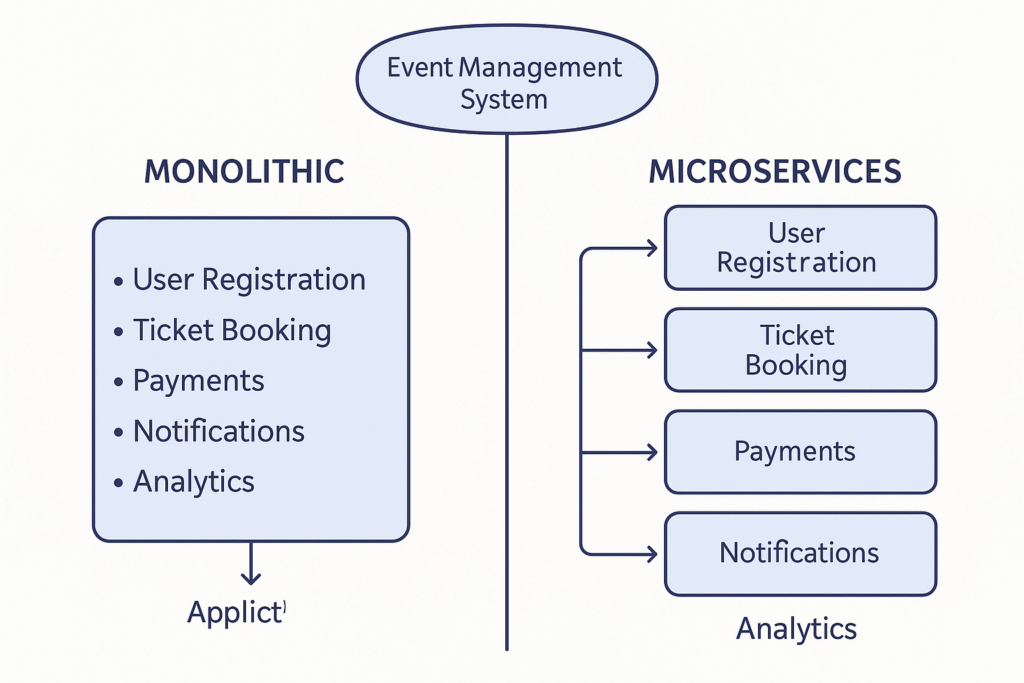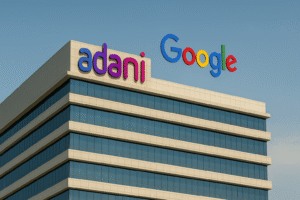Introduction
Event management systems power conferences, concerts, exhibitions, and corporate events by handling registrations, ticketing, payments, schedules, and notifications. When building such a system, one of the most important architectural decisions is whether to use a monolithic or a microservices approach.
In this blog, we’ll compare the two, discuss their pros and cons, and help you decide which is better for your event management platform.
Understanding the Architectures
What is a Monolithic Architecture?
- A single unified codebase that contains all features (user registration, ticket booking, payments, notifications, analytics).
- Runs as one application on a server.
- Example: A Django or Laravel app where all modules are tightly coupled.
What is a Microservices Architecture?
- Application broken down into independent services (registration service, payment service, notification service, analytics service).
- Each service runs independently and communicates via APIs.
- Example: A Node.js microservice for payments, Python/Django service for user management, and a Java service for reporting.
Pros and Cons
✅ Monolithic Architecture
Advantages:
- Simple to build & deploy – One codebase and a single deployment pipeline.
- Lower cost – Cheaper to start, fewer infrastructure requirements.
- Good for small teams – Easier to manage in early stages.
Disadvantages:
- Scalability issues – Scaling means deploying the entire app, even if only one module needs more resources.
- Slower updates – A bug in one part can affect the entire system.
- Harder to adopt new tech – Everything must run on the same stack.
✅ Microservices Architecture
Advantages:
- Scalable & flexible – Each service can scale independently (e.g., scale ticket booking during a high-demand event).
- Faster development – Teams can work on services independently using different tech stacks.
- Fault isolation – If the notification service fails, registration still works.
- Easier innovation – Can adopt new technologies for individual services.
Disadvantages:
- Complex setup – Requires orchestration (Kubernetes/Docker) and API management.
- Higher costs – More infrastructure overhead compared to monolithic.
- Monitoring challenges – Requires observability tools like Prometheus or AWS X-Ray.
When to Choose Monolithic for Event Management
- You are building an MVP or a small-scale event system (local concerts, workshops, internal corporate events).
- Your team is small (1–5 developers).
- Budget is tight, and speed of initial development is more important than scalability.
- Example: A small React + Django app for managing 500 attendees at a conference.
When to Choose Microservices for Event Management
- You’re targeting large-scale events (music festivals, global conferences, multi-day expos).
- Need real-time scaling (ticket sales can spike massively).
- You want flexibility in technology (e.g., AI-based recommendation engine built in Python while payments run on Node.js).
- You need high availability and fault isolation (downtime means lost revenue).
- Example: A multi-service system handling 1M+ ticket sales across different geographies.
Hybrid Approach: The Best of Both Worlds
Some event management systems start as monolithic and later transition to microservices as the business grows. This approach works well if you:
- Begin with a monolithic MVP for speed and cost savings.
- Gradually extract high-demand modules (payments, notifications) into microservices.
- Use API gateways to manage communication between services.
Real-World Example
- Monolithic Case: A small corporate HR team uses a Django-based system to manage in-house training events.
- Microservices Case: Ticketmaster uses microservices to handle millions of ticket requests per minute with independent scaling.
Conclusion
Choosing between monolithic and microservices for an event management system depends on your scale, budget, and growth plans.
- Go Monolithic if you’re a startup or building a small-scale solution.
- Go Microservices if you’re aiming for enterprise-level scalability and resilience.
- Consider a hybrid strategy to evolve over time.








